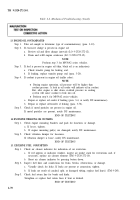TM-9-2320-272-24-1 - Page 157 of 1015
TM 9-2320-272-24-1
Table 2-2. Mechanical Troubleshooting (Contd).
MALFUNCTION
TEST OR INSPECTION
CORRECTIVE ACTION
NOTE
Perform step 3 for M939A2 series vehicles.
Step 3.
Check turbocharger for oil leaking into air intake or exhaust.
a.
Remove air intake tube from turbocharger inlet.
b.
If oil is present in air intake, or excessive smoke is seen, replace turbocharger
(para. 3-21).
END OF TESTING!
12. ENGINE OIL PRESSURE TOO LOW OR TOO HIGH AT NORMAL OPERATING TEMPERATURE
Step 1.
Check engine oil level (TM 9-2320-272-10).
If dipstick has been read correctly and indicates low or excessive oil, refill or drain
crankcase to proper operating level (TM 9-2320-272-10).
Step 2.
Check oil supply lines for cracks, splits, leaks, damage, or obstructions.
a.
Tighten loose fittings and connections.
b.
Replace cracked, split, or damaged oil lines.
Eyeshields must be worn when cleaning with compressed air.
Compressed air source will not exceed 30 psi (207 kPa). Failure to
do so may result in injury to personnel.
c.
Clear clogged or obstructed lines with compressed air or sturdy wire.
Step 3.
Inspect oil filter for leaks.
a. Tighten oil filter.
b.
If leaking persists, replace oil filter (para. 3-5).
NOTE
If STE/ICE is available, perform NG05 - Low Oil Pressure Check
(para. 2-24).
Step 4.
Check oil pressure gauge, sending unit, and electrical lead for malfunction.
a.
Refer to electrical troubleshooting (para. 2-22).
b.
If defective, replace oil pressure sending unit (para. 3-91).
c.
If defective, replace oil pressure gauge (para. 3-86).
NOTE
Perform step 5 for M939A2 series vehicles.
Step 5.
Check oil pressure regulator plunger and ensure it moves freely.
a.
Remove oil filter head (para. 3-4).
b.
Remove oil pressure regulator plunger and spring from oil filter head (para. 3-4).
c.
Clean oil pressure regulator plunger and ensure it moves freely in bore.
d.
If restricted, replace oil pressure regulator plunger.
e.
If low oil pressure is not corrected, notify DS maintenance.
END OF TESTING!
2-69
Back to Top




















